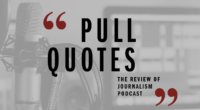Looking back at the past five years of Indigenous coverage in our magazine
By Julia Duchesne
In 2015, the Truth and Reconciliation Commission of Canada, which has since been succeeded by the National Centre for Truth and Reconciliation, released its 94 Calls to Action. Number 86 urged Canadian journalism programs to “require education for all students on the history of Aboriginal Peoples, including the history and legacy of residential schools, the United Nations Declaration on the Rights of Indigenous Peoples, Treaties and Aboriginal rights, Indigenous law, and Aboriginal–Crown relations.”
In the nearly six years since then, how has the Review’s coverage reflected its response to this call?
Our magazine is staffed and written by Ryerson University journalism students. We don’t have many stories written by Indigenous students, partly because Indigenous enrolment at Ryerson has reportedly been stagnant since 2014. Still, as part of our mission to examine and critique journalism practices in Canada, the Review regularly tackles stories about Indigenous representation in the news. Here is a sampling of the publication’s work since 2016 featuring Indigenous voices, stories, or writers.
The Long, Dark Trail, by Emily Latimer (2020)
Latimer’s look at the ethics of true crime podcasts includes CBC’s 2018 investigative podcast Missing & Murdered: Finding Cleo. The podcast follows the story of a young Cree girl, Cleopatra Semaganis Nicotine, and her siblings, all of whom were taken from their mother and separated during the Sixties Scoop. Through the 1960s to1980s, provincial child welfare authorities took thousands of Indigenous children from their homes and placed them into foster care or adopted them out to mostly non-Indigenous families, severing their cultural ties. One of the creators of the podcast, Cree journalist Connie Walker, worked closely with Cleo’s sister Crystal Cameron during the making of the show. “Small ways of changing your thinking can be really powerful for people, and can inevitably lead to a better story and to a more authentic truth,” says Walker.
Hidden History, by Madeline Cornacchia (2019)
Falen Johnson and Leah-Simone Bowen are the hosts and creators of the podcast The Secret Life of Canada. Together, they cover Canada’s under-told histories, such as its history of slavery or the Canadian government’s forced relocations of Inuit. In Cornacchia’s story, Johnson, who is Mohawk and Tuscarora from Six Nations, and Bowen, a first-generation Canadian of Barbadian descent, talk about how their podcast started and the history of journalists working in marginalized communities. Rather than extracting people’s stories, they want to connect with community members who can tell their own stories.
The Path to Healing, by Alexa Taylor (2019)
Through the lens of the HIV-AIDS crisis in Saskatchewan, Taylor looks at the extractive, exploitative history of health reporting in Indigenous communities and how journalists can improve it. Taylor notes that better health coverage includes context about the socio-economic factors of the epidemic and the ways that Western medicine excludes Indigenous Peoples from health care. It also includes covering community-based solutions such as the Know Your Status campaign, a joint initiative of the Saskatoon Tribal Council and several Saskatchewan First Nations to combat the stigma of HIV and combine Western medicine with traditional healing. Taylor interviews CBC journalist Ntawnis Piapot, who is Cree and a member of Piapot First Nation, about showing the humanity of Indigenous people with HIV. Piapot’s mother, Elvina, lived with HIV for 25 years and was a funny, fierce, and encouraging presence in her life.
Louder than Thunder, by Rhiannon Johnson (2018)
This cover story is a thoughtful, thorough portrait of Tanya Talaga by Anishinaabe journalist Rhiannon Johnson. The piece walks us through Talaga’s journey to publishing Seven Fallen Feathers, her book about seven Indigenous youth who died in Thunder Bay, Ontario. Along the way, we learn more about Talaga’s writing process, what brought her to the story in Thunder Bay, and what her career means to the next generation of Indigenous journalists, including Johnson.
Indigenous First, by Karen McCall (2017)
McCall takes a deep dive into Indigenous news network APTN. Through interviews with journalists, producers, and management, including Karyn Pugliese (now an assistant professor in Ryerson’s journalism faculty), Paul Barnsley, and Jean La Rose, this feature delves into APTN’s history and the network’s approach to topics ranging from the Harper-era Bruce Carson corruption scandal to child welfare and Standing Rock.
Silenced No More, by Erin Sylvester (2016)
Sylvester takes us to Peawanuck in northern Ontario, one of four communities that took part in an intensive journalism training course with Journalists for Human Rights in 2015. With JHR’s guidance, new journalists, including Pam Chookomoolin, began writing stories about life in Peawanuck, a community with a long tradition of storytelling. Sylvester addresses stereotypical, inadequate, and inaccurate representations of Indigenous stories in Canadian media, and looks at emerging journalists and Indigenous bureaus in organizations such as the CBC.

![Indigenous Journalism with [ ] Review of Journalism photo](https://s38447.pcdn.co/wp-content/uploads/2021/04/Image-from-iOS.jpg)

![Indigenous Journalism with [ ] Review of Journalism photo](https://s38447.pcdn.co/wp-content/uploads/2021/04/Image-from-iOS-150x150.jpg)